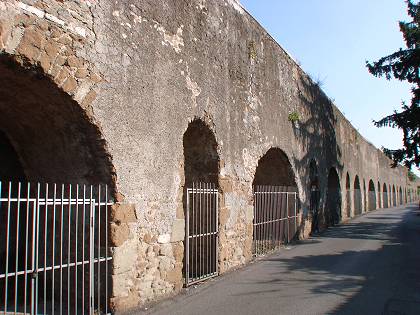
the Acqua Felice, crossing Rome's south-eastern districts |
The Salone Water (i.e. the ancient Aqua Virgo) and the fountains that had been built so far represented a great improvement for the city, but already in the late years of his reign pope Gregory XIII thought of restoring a second aqueduct. This time it would have entered the city from the south, in order to cover the districts of Rome that the Salone Water was not able to reach.
The choice fell on the old springs of the Aqua Alexandrina, located about 23 km (14 miles) east of the city. The death of Gregory XIII stopped the project, but the following pope Sixtus V, partly moved by reasons of personal interest, had the works resumed immediately after his election, and hastily completed them within two years (see Aqueducts page 6 for more details). The viaducts of the new aqueduct, named Acqua Felice (or Aqua Felix, in Latin texts), were made by using again the remaining arches of the ancient Aqua Claudia and Aqua Marcia, whose course next to the city overlapped that of the Aqua Alexandrina; only the missing parts were built as a new structure. |
Also in this case a program for the making of new fountains was agreed. First of all, an imposing one for the aqueduct's main outlet (a so-called 'display fountain', no.1 in the map below); then one for each of the following spots:
piazza Madonna dei Monti (10);
Campo Vaccino (5);
piazza Santi Apostoli;
somewhere near Trajan's column |
|
the square below the Capitolium (4);
piazza Altieri (now piazza del Gesù);
piazza Montanara (5, no longer existing);
on the corner of Tor de' Specchi's monastery (7). |
Three of them were never built, namely the fountain near Trajan's column, the one in piazza Santi Apostoli and the one in piazza Altieri (the last two had already been cancelled also from the previous program, under Gregory XIII). However, they were replaced by three more fountains that had not been scheduled:
one for the Senators Palace, on the Capitolium Hill (4);
one located on one side of the same Capitolium square (4);
one in piazza Giudia, just outside the Ghetto (Jewish district) (9).
It may appear strange how, once again, the new fountains were concentrated in a rather small part of the urban area, but
the previous aqueduct had left almost dry the Quirinal hill, where the pope had his summer residence, and the Capitolium hill, the heart of Rome's administration, whereas the southern and eastern districts during the Renaissance were still poorly inhabited.
|


|
One more fountain was built in front of the Quirinal Palace (3) at the expenses of the Church of Rome, i.e. not as a municipal work, and another one below the Lateran obelisk (11) was payed for by the Chapter of St.John's. The owner of Villa Medici had one built in front of his mansion, above the Pincio hill (12). Furthermore, some private families were given funds, water, and sometimes marble for the making of semipublic fountains (2, 6, 8).
So after the opening of the Acqua Felice, Rome was given fourteen new fountains; this total, though, does not include a number of small ones, and the three ones built outside the city walls, on the spots where the Acqua Felice crossed main roads
(such as the so-called fountain of Clement XII, see part II page 2)
Before his election as Sixtus V, the relations between cardinal Peretti and the previous pope Gregory XIII, had not been very warm; in particular, the cardinal was particularly fond
of his villa on the Esquiline hill (whose boundaries he enlarged after becoming pope), and Gregory XIII had
frowned upon such a material interest. This explains why the official fountain-maker, Giacomo Della Porta, 'guilty' of having celebrated Gregory XIII with so many fountains, was kept in lesser consideration. Altough his activity as an architect and a fountain-maker continued also during Sixtus V's reign, he was denied the commission for the fountains built on the three most important spots, namely by the aqueduct's end (see below), in the square in front of the Quirinal Palace, and on the Capitolium hill.
|
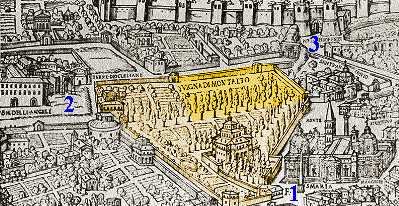
Villa Montalto (in yellow), privately owned by Sixtus V, that stretched from
the basilica of Santa Maria Maggiore (1), to the Baths of Diocletian (2) and
to Tiburtina Gate (3); the area whose colour is deeper indicates the site
of today's Termini railway station; no part of the villa is still standing |
Della Porta was not even consulted when, during the making of the Acqua Felice, the aqueduct's inclination was found to be wrong, and a whole team of experts had to be called by the pope in order to find a solution.
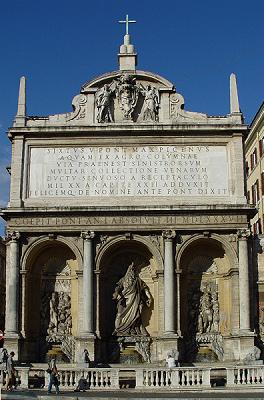 |
THE FOUNTAIN OF MOSES
(DISPLAY OF THE ACQUA FELICE)
The first fountain reached by the Acqua Felice was a so-called 'display fountain', i.e. a lavish way of celebrating both the hydraulic infrastructure and its sponsor, on the same spot where the main duct reached its end. This was the first fountain of its kind to be built in Rome. In fact. despite the other aqueduct, called Salone water (or Aqua Virgo, in Roman times), was already working, it had an average-sized fountain at its end, that was replaced with a real 'display' only in the 18th century (see the Trevi Fountain, page 17).
The Acqua Felice ended in a rather poorly inhabited district (see map detail below), still covered with ruins of the nearby Baths of Diocletian, but high enough to let the water reach the central districts, flowing downhill.
← the Fountain of Moses |
The pope wanted this fountain to be a glamorous celebration of his sponsorship. Almost half the height of the whole structure is represented by his family coat of arms and the enormous inscription, that mentions Sixtus V, the location of the springs (the countryside near Colonna), the route followed (via Prenestina), the aqueduct's length (20 miles, 22 including the length of the water springs), and how it was called "Felice" after the same pope's name.
A further line remembers that the work was begun in year I, finished in year III, 1587. |

view of the district in 1593 (looking eastwards):
1. the fountain - 2. Baths of Diocletian -
3. Four Fountains crossing -
4. corner of Sixtus V's villa - 5. Porta Pia,
the gate leading to via Nomentana |
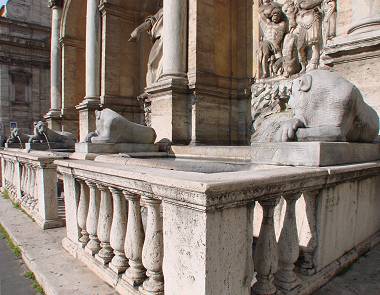 |
Domenico Fontana, in charge of the making of the fountain, divided the lower part into three identical niches, marked by columns, whose central one contains a large bearded statue of Moses; the personage refers to the biblical episode in which the leader of the Jews made water spring from a rock by striking the latter with his staff.
Each of the side niches contains a large panel, featuring a different biblical episode related to water.
Below the columns are four crouching lions, that spout water in rectangular basins, enclosed by a balustrade.
← the set of lions |
By the time the aqueduct was opened, the fountain was still unfinished, and most of its figures were yet to be carved. In fact, it was not called 'fountain of Moses', but Fountain of the Acqua Felice, as the aqueduct. Only two of the four lions were already in place: they were the so-called lions of Nectanebo I (an Egyptian pharaoh of the mid 4th century BC), which originally decorated the Iseum Campensis temple; they had been found during the first half of the 1400s, and about one century later Clement VII had set them before the Pantheon (see also the fountain of piazza della Rotonda, page 4). The other two lions, insted, were carved on purpose for the Fountain of the Acqua Felice.
The pope likely urged Fontana to finish the fountain as soon as possible, but such hurry affected the quality of the final result. Despite the overall look of the work is quite imposing, the artistic value of the two side reliefs is rather modest, not to mention the central figure of Moses; soon after being set into the niche, everybody noticed that the statue is stout and rather short. Furthermore, Moses holds in his left hand the Tables of the Law which, according to the Bible, he had not been given yet by the time he made the water spring. |
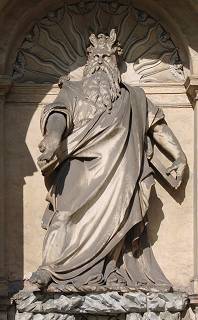
the criticized Moses |
 |
The people nicknamed the figure 'the ridiculous Moses', and even the talking statues shed a few stinging puns about the poor quality of the work, referring to it as fons infelix ("unhappy/unsuccessful fountain").
The work was so hasty that while the left panel undoubtly features Aaron (Moses' brother) showing the people of Israel
the source of water, the theme of the right panel is still debated. The original documents describe it either as Joshua leading the Jews across the river Jordan, or as Gideon choosing his soldiers by the way they drink; although in most publications the first of the two interpretations is mentioned, the soldiers and the drinking figures in the panel make the other theme appear more likely (run the mouse cursor over the picture for the relevant biblical passage).
← the right panel likely features Gideon choosing his soldiers |
The author of the 'ridiculous Moses' was initially mistaken; for a long time he was believed to be sculptor Prospero Antichi, better known as Prospero da Brescia, who according to a popular belief is said to have died of grief, because of the people's criticism; but now we know that the statue was almost certainly finished by the more obscure sculptor Leonardo Sormani.
The balustrade reveals another trace of Fontana's hurry: simply taken from a preexisting building, it bears the inscription PIVS IIII (a pope who had reigned some 25 years earlier), clearly readable, though never chiselled off, nor covered. |
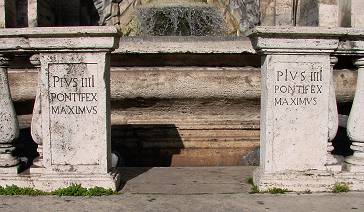
the balustrade bears the name PIVS IIII |
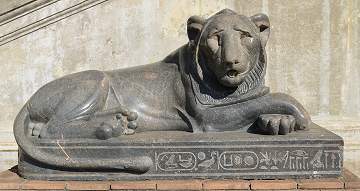 |
In 1839 pope Gregory XVI had the two original lions moved to the Egyptian section of the Vatican Museums, and replaced them with copies, as a Latin inscription on their base says.
← one of the two original lions of Nectanebo I (now in the Vatican Museums)
The bad reputation of the statue did not vanish in time; in a sonnet dated 1928, the Jewish-Roman poet Crescenzo Del Monte mentions it in these verses:
|
E anze, te poss'aggiògne, a 'sto reguardo
ch'era un tappetto: alla Torà 'unn'è ditto
ma 'o vedi a la fontana a Sa' mmennardo:
che da lontano par'assiso, e invece
come t'accosti te lo vedi dritto,
e questo dunque nun te faccia spece.
(da Moscè-Rabbèno, 4 settembre 1928)
|
|
Better still, in this regard I can also tell you
that [Moses] was a shorty: the Torah does not say so,
but you can see this by the fountain near St.Bernard's:1
because from afar he appears to be sitting, instead
as you get closer, you see he's standing,
so don't be surprised about it.
1. - the church of San Bernardo alle Terme, close to the fountain.
|
|